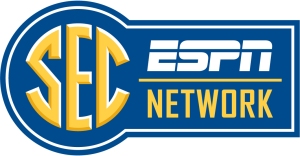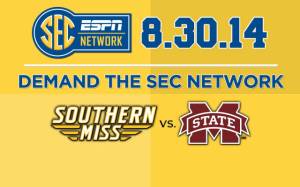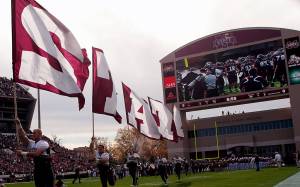In less than three weeks, the SEC Network launches, and in less than four, Mississippi State will broadcast and produce its first game for the nationwide source of SEC sports.
 The good news for MSU, according to Senior Associate A.D. for External Affairs Scott Wetherbee, is that his department is one of a handful across the conference who is “game-ready” already. In fact, MSU was one of the most prepared of them all for the soon-to-launch network, largely because of the University Television Center already in place on campus and the long-standing HailStateTV, home to live in-house broadcasts of Bulldog athletics.
The good news for MSU, according to Senior Associate A.D. for External Affairs Scott Wetherbee, is that his department is one of a handful across the conference who is “game-ready” already. In fact, MSU was one of the most prepared of them all for the soon-to-launch network, largely because of the University Television Center already in place on campus and the long-standing HailStateTV, home to live in-house broadcasts of Bulldog athletics.
Of course, that doesn’t mean MSU was ready to broadcast when the SEC Network was announced one year ago. No one in the conference was, as there has been a cost of preparation for all 14 schools.
For MSU, the total cost will come in two installments.
The initial investment for MSU was a relatively affordable first step, thanks largely to already having an HD control room because of the video board at Davis Wade Stadium.
Most of that cost involved upgrading the control room, as well as purchasing more and better equipment (such as $100,000 camera lenses).
However, the second phase of investments will begin soon and is expected to be a much larger bill. MSU will build a second, newer control room in Davis Wade Stadium (offering the ability to broadcast multiple events at the same time), a new studio, new offices and several other necessities.
It’s a good bit of money to spend for schools who haven’t yet seen a dollar, though they of course expect to recoup the cost, and hopefully within a couple of years according to Wetherbee, MSU’s point person for the SEC Network.
“We’re all taking a risk knowing that the gain on the back end is going to be pretty good,” he said. “We’re all kind of grasping at straws for what we’re going to get, and every time you get another announcement of a distributor, that’s more revenue for the schools.”
As it stands now, the SEC Network has a solid base of distributors and is regularly signing on more, with optimism that they will add more heavy hitters in the coming weeks and reach a point of significant revenue for ESPN and the SEC, as well as blanket coverage of the southeast.
So, what happens once the Network launches?
 Well, football this fall will be like football always is: on TV and covered heavily. The changes will come from the more in-depth and frequent coverage of individual schools from an entity only charged with covering 14 teams, rather than all of sports across the globe.
Well, football this fall will be like football always is: on TV and covered heavily. The changes will come from the more in-depth and frequent coverage of individual schools from an entity only charged with covering 14 teams, rather than all of sports across the globe.
The big difference in availability will be for all the other sports on campuses.
Volleyball and soccer matches this fall, like other sports in the spring, will be broadcast either on the SEC Network channel or on SEC Network+, ESPN’s online/digital platform for the network similar to Watch ESPN or ESPN3. Those broadcasts will come in three tiers.
First are games produced by ESPN and broadcast on the SEC Network channel available through cable and satellite. Second are games broadcast exclusively on SEC Network+, which will be produced by the schools themselves using their own equipment, talent, etc. The third tier of games are those the SEC Network has not picked up for either of the first two tiers, but that the schools can produce and broadcast themselves as part of SEC Network+, if they so choose.
Wetherbee says MSU’s plan is to broadcast games themselves in the tier three option whenever they aren’t picked by the network initially, meaning nearly all of MSU’s contests in all sports will be available in some fashion to those with a subscription to a cable or satellite service providing the SEC Network.
Basketball and baseball will be heavily featured on the Network, as well, and previously hard-to-watch events like the SEC Baseball Tournament in Hoover will become easily accessible. Next spring, for example, MSU will be host to the SEC Track and Field Championships and it will be broadcast from campus.
Big news for State fans and an excitement that’s felt throughout the conferences fanbases.
Beyond the broadcast of the games for sports who didn’t previously get it, MSU will also have more chances to promote its teams, players, coaches and academics. Like any broadcast on TV, there will be down time. When MSU is producing the game, it’s their job to fill it.
“If we get a three minute break in a match, we could fill it with anything,” Wetherbee said after mentioning the opportunity to highlight some of MSU’s more successful programs. “They want us to be neutral with the on-air talent, but that doesn’t mean we can’t show something special that’s going on around campus.”
Halftime could be a feature on the women’s golf team. A break between volleyball matches could be an opportunity for a live interview with baseball coach John Cohen. Timeouts may be a chance to plug Rick Ray, Vic Schaefer and the basketball teams.
In fact, Wetherbee said, the university’s academic side has been producing segments to play in such instances where they could feature people like Field Brown, the school’s newest Rhodes Scholar.
Doing all of this, however, requires a lot of work and a lot of time. MSU will be looking at around 15 people needed per broadcast for things like softball, soccer or volleyball, and it’s their job to line up the cameramen, on-air talent, producers, directors – the works.
MSU was lucky to already have fiber on campus – a million-dollar expense for some other schools – and already had the football, baseball and basketball facilities wired. All they had to do was connect volleyball, softball and soccer to the existing fiber, like adding a string of Christmas lights to an already-lit tree.
 Just this week, MSU built a small studio space in the Seal Football Complex, a ‘Bureau Cam,’ it’s called, where anyone can sit and automatically be live and on-air with ESPN studios in Bristol or Charlotte.
Just this week, MSU built a small studio space in the Seal Football Complex, a ‘Bureau Cam,’ it’s called, where anyone can sit and automatically be live and on-air with ESPN studios in Bristol or Charlotte.
“If Finebaum comes in with SEC Nation,” Wetherbee began as an example, “he’s going to actually do his radio show in the Bureau Cam so that he can be on TV and do the show from there.”
If SportsCenter wants to do a live interview with Dan Mullen, he just has to walk down the hall and he’s connected to the studios in Connecticut.
In the coming days of producing, connecting, broadcasting and creating, MSU’s heavy experience is a big plus for the department and makes them someone the SEC Network will lean on.
ESPN has recognized that not all schools will be ready to produce at the highest of levels and they have stressed for departments not to try to produce beyond their means.
Given the already-existing facilities and experience, Wetherbee says MSU will be one of the schools to “go full-bore” from the start with multi-camera productions of network quality.
“At first,” Wetherbee recalled from meetings and calls last summer, “everyone was gung-ho saying ‘We’re going to do four or five cameras and have a full production,’ but then reality sets in and some are saying, ‘We’re going to back off and maybe do two cameras.’
“But we’re going to try to go full-bore and make it so no one knows whether we’re doing it or if they brought in a truck from ESPN and SEC Network.”
While Wetherbee recognizes there will be a learning curve, he’s confident in MSU’s preparedness for the SEC Network to launch, and he loves the benefits it will bring to the school and its fans.




Great story.